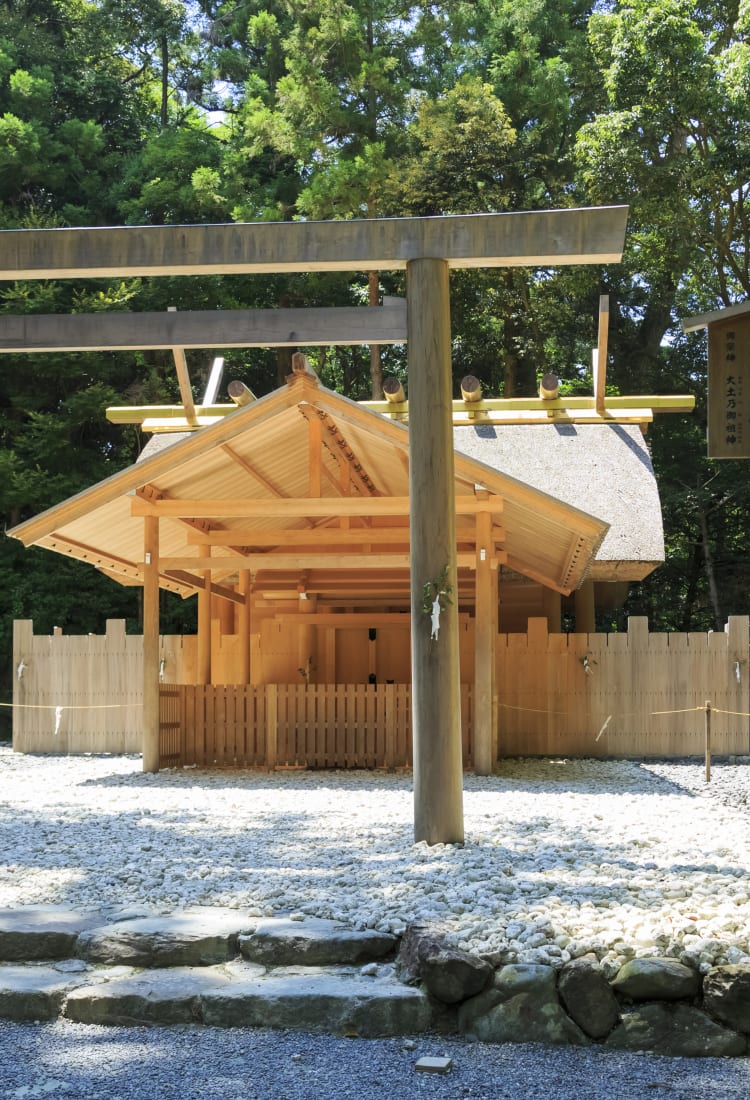

MIE Ise Ise, die Heimat einer Gottheit, die mit der Sonne verglichen wird, und dynamisches Zentrum des Shinto-Glaubens, bietet neben Naturwundern auch kulinarische Köstlichkeiten
Ise, die Heimat einer Gottheit, die mit der Sonne verglichen wird, und dynamisches Zentrum des Shinto-Glaubens, bietet neben Naturwundern auch kulinarische Köstlichkeiten
Mit dem heiligen Ise-jingu als Mittelpunkt gibt es rund um die Ise-Bucht im Osten von Mie viel zu sehen und zu erleben. Neben der Erforschung der religiösen Seite dieser Region haben Sie reichliche Möglichkeiten, historische Viertel zu erkunden, sich an Sandstränden zu entspannen und lokale Spezialitäten wie Langusten und Abalone-Muscheln zu genießen.
Nicht verpassen
- Die mystische Atmosphäre von Ise-jingu
- Geraspeltes Eis außerhalb des Naikus aus einem Geschäft auf der Oharaimachi-Straße
- Entspannen am Strand von Toba
Anfahrt
Die Ise-Bucht ist leicht mit der Kintetsu-Bahn von Osaka und Nagoya aus zu erreichen.
Die Stadt Ise ist ein häufiger Ausgangspunkt für Reisen in der Region. Der Bahnhof Ise-shi ist etwa 1 Stunde 45 Minuten von Osaka, 2 Stunden von Kyoto und 1,5 Stunden von Nagoya mit dem Kintetsu Limited Express entfernt.
Die Seele Japans
Der Shinto-Glauben ist Japans ursprüngliche Religion und der Ise-jingu besteht aus 125 Schreinen, darunter die Hauptheiligtümer Naiku und Geku. Naiku ist die heiligste Stätte, in der Amaterasu Omikami, die Gottheit, die mit der Sonne verglichen wird, verehrt wird. Sie können Ise-Jingu und die Umgebung in einem Tagesausflug besuchen. Mit einer Übernachtung steht Ihnen für die Besichtigung mehr Zeit zur Verfügung.


Geku und das Sengukan-Museum
Der Naiku von Ise-Jingu ist berühmt. Aber auch der Geku und das etwa 5 Kilometer entfernte Sengukan-Museum sind einen Besuch wert. Beide befinden sich im Zentrum von Ise, etwa 10 Gehminuten vom Bahnhof Iseshi entfernt. Die Architektur des Gekus ist ähnlich wie die des Naikus, auch wenn es einige Unterschiede zwischen den beiden gibt.
Das Sengukan-Museum veranschaulicht das Shikinen Sengu (Schreinverlegungsritual) des Ise-Jingu anhand einer Vielzahl von Exponaten. Dazu gehören eine Rekonstruktion der Struktur, in der eine Gottheit verehrt wird, in Originalgröße und Anleitungen zur Herstellung von heiligem Schmuck und Schätzen für die Gottheiten.

Naiku
Naiku ist der Gottheit Amaterasu Omikami gewidmet, die mit der Sonne verglichen wird und als mythischen Vorfahrin der aufeinanderfolgenden japanischen Kaiser gilt. Es wird auch berichtet, dass in ihm ein heiliger Spiegel aufbewahrt wird, der Yata-no-kagami, ein Symbol der Gottheit, und der Teil der kaiserlichen Insignien ist.
Oharaimachi-Straße, außerhalb des Naikus, ist eine lange, gewundene, altertümliche Straße, die von Geschäften und Restaurants gesäumt ist. Es lohnt sich, ausreichend Zeit zum Entdecken mitzubringen.
Um auf das Gelände des Naikus zu gelangen, überqueren Sie die hölzerne Ujibashi-Brücke und passieren die Torii-Tore auf beiden Seiten. Dies soll die Besucher reinigen, bevor sie die heiligen Stätten betreten.


Auf dem gesamten Gelände gibt es viele interessante angegliederte Schreine und andere Shinto-Bauwerke, das Hauptgebäude des Naikus wird jedoch gegen Einblicke der Besucher geschützt. Die stimmungsvolle Atmosphäre macht einen Spaziergang durch die üppige Natur jedoch zu einem unvergesslichen Erlebnis.




Einkaufsmöglichkeiten und Gastronomie
Nach dem Besuch von Ise-jingu schlendern Sie durch die nahe gelegene Oharaimachi-Straße und über den Okage-Yokocho-Platz, um kulinarische Angebote wie Ises überdicke Udon-Nudeln und geraspeltes Eis zu probieren. Ise ist berühmt für seinen grünem Tee. Wenn Sie ein Liebhaber dieses Tees sind, sollten Sie unbedingt eine Tasse trinken. Die Gegend ist auch ein guter Ort, Geschenke für Freunde und die Familie auszuwählen.


Die Umgebung von Ise
Ise ist zwar der Hauptanziehungspunkt der Gegend, aber auch Matsusaka und Tsu sind lohnende Ziele.
Matsusaka war einst eine blühende Handelsstadt mit einer Burg, die über dem Gebiet thronte. Die Mauern der Burg können immer noch von Touristen erkundet werden. Heute ist die Stadt durch das stark marmorierte Matsusaka-Rindfleisch bekannt, das mit dem bekannteren Kobe-Rindfleisch konkurriert und, wie einige sagen, dieses übertrifft. Daraus wird sogar Sushi hergestellt. Yakitori aus Matsusaka, überzogen mit Miso, hat sich auch bei Feinschmeckern einen hervorragenden Ruf erworben.


Tsu ist ein idealer Ausgangspunkt für Ausflüge in andere Gebiete der Präfektur Mie. Wenn Sie in der Stadt sind, sollten Sie das Kunstmuseum der Präfektur Mie besuchen, das westliche Kunst von japanischen Künstlern zeigt.
Sonnenanbeter und Meeresliebhaber finden zahlreiche Strände entlang der Ise-Bucht, insbesondere in Toba, südlich von Ise.




















































